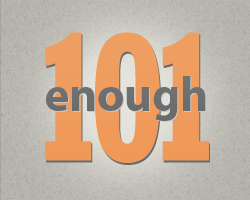
Editor’s Note: This week's post in the series Enough 101 looks at the history of Somalia from the end of direct Western military engagement in the early 1990s through the present, building off of two previous posts that covered challenges to dictatorship through Black Hawk Down, 1976-1990s, and colonialism to independence to dictatorship from 1840 to 1976.
Acronyms to Know
TFG – Transitional Federal Government
ICU – Islamic Courts Union
AMISOM – African Union Mission in Somalia
ARPCT – Alliance for the Restoration of Peace and Counter-Terrorism
With the coming of the new millennium, after over two decades of war and a series of 14 reconciliation efforts over 13 years, Somalia was ready to take serious steps towards peace.
Various neighboring countries hosted the series of peace negotiations (Djibouti, Eritrea, Ethiopia, Egypt, Yemen, Kenya, and Libya, all of which backed different Somali factions at different times), and eventually led to the creation of the Transitional Federal Government, or TFG, in August 2004. The TFG, originally led by President Abdullahi Yusuf Ahmed, was intended to be a government of national unity, tasked with administering a five-year political transition. But many Somalis, especially clans in and around the capital of Mogadishu, saw the TFG as an Ethiopian puppet supporting self-serving the clans of TFG leadership.
By early 2005, the TFG was unable to secure its own capital. The streets of Mogadishu were again the location of clan-based warfare, and the U.S. returned to Somalia’s conflict, this time through an effort to counter the rise of the Islamic Courts Union, or ICU, and its increasingly powerful militant offshoot, al-Shabaab. The C.I.A.-backed Alliance for the Restoration of Peace and Counter-Terrorism, or ARPCT, was quickly defeated and subsequently accused of empowering the extremists it intended to defeat.
Through 2006, the ICU gained controlled of all of Mogadishu and most of south-central Somalia, and enjoyed support from many war-weary Somalis. The ICU, which enforced sharia law and preached an extreme interpretation of Islam, was vocally opposed to Ethiopia. When Ethiopian troops invaded Somalia in July 2006, the ICU declared jihad on Ethiopia, calling on international recruits to come fight for Islam.
But soon the tables turned against the ICU. The U.S. and its allies supported the Ethiopian military intervention into Somalia, and the U.S. lent airstrike capacity. The conflict was brief and decisive, and by the end of December 2006 the TFG was re-established in Mogadishu and Ethiopian troops occupied the capital.
But in response to the Ethiopian invasion, al-Shabaab ramped up its terrorist efforts against the occupying troops, rallying some grassroots support through its anti-intervention posture. In early 2007, the African Union Mission in Somalia, or AMISOM, deployed to protect the TFG. (Ethiopian forces did not withdraw until early 2009.)
From July 1, 2007 to June 30, 2008, Somalia ranked as the most dangerous place in the world for humanitarian workers—20 aid workers were killed in that period by al-Shabaab, TFG-allied forces, and other groups. This accounted for almost a third of the 65 humanitarian casualties worldwide during that period and two more humanitarian deaths than occurred in Afghanistan, which is widely considered the most dangerous humanitarian operation in the world.
In January 2009, the TFG elected a new parliament and extended its mandate for two years. However, the new government, with President Sheikh Sharif Sheikh Ahmed at its head, continued to struggle for control over the country. Islamist insurgents began yet another attack on Mogadishu in May 2009. Al–Shabaab controlled most of south-central Somalia and Mogadishu until TFG forces and AMISOM launched an offensive effort in early 2011. By August 2011, the TFG had regained control of the capital, but as The New York Times speculated, “that term seems more aspirational than meaningful.”
In February 2011, the TFG extended its mandate by three years, giving itself power up until August 2014; however, as a result of international opposition, the mandate extension was shortened to one year. Per the Kampala Accord, the TFG will have finished all transitional tasks (including constitutional and parliamentary reform and elections) and set up a permanent government by August 2012.
While the TFG focused on power-sharing accords and the implementation of transitional tasks, the country descended into famine. Similar crisis occurred in 1991/1992 and 2009, both due to a combination of drought and security issues. Armed groups blocked food and aid and attacked international aid workers, leaving hundreds of thousands of Somalis to starve. In the 2011 famine, al–Shabaab was the primary culprit, blocking aid from getting in and stopping starving people from escaping the country. Tens of thousands of Somali refugees flooded camps in Ethiopia and Kenya, at a rate at the height of the crisis of more than 3,000 new arrivals per day. The U.N. estimated that a quarter of the population is either internally displaced or living outside the country. The U.N. declared famine conditions in July 2011, calling it the worst drought in 60 years.
In a "change of military tactics,” al-Shabaab pulled out of Mogadishu in August 2011 and instead focuses attacks on Kenyan border. Allegedly in retribution for kidnappings, Kenyan troops invaded Somalia in October 2011, and reports have emerged of alleged U.S. drone attacks against al-Shabaab targets.
On February 3, 2012, the U.N. announced that the famine was officially over, though an estimated 50,000 to 100,000 people died and hundreds of thousands of remains at risk.
With the help of AMISOM, the security situation in Somalia is slowly improving. The U.N. is considering expanding the mission to nearly 18,000 peacekeepers to include Kenyan forces already in Somalia.
For more information and to see the sources used in this post, check out the Enough Project's Somalia Pinterest Board.

